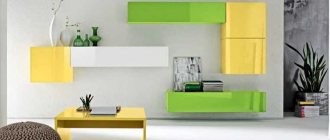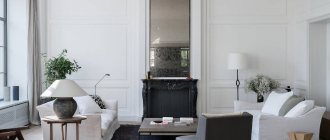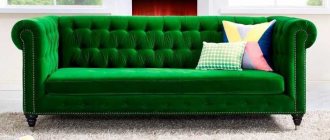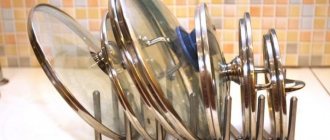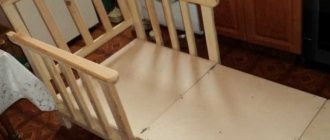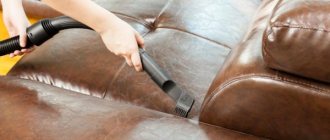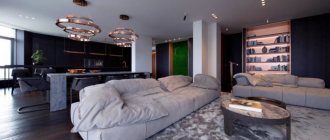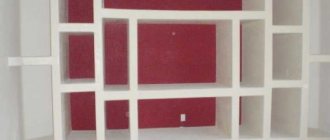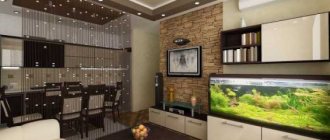Creating comfort and coziness
What do most people associate upholstered furniture with?
Of course, first of all, with comfort and coziness, and therefore with rest, peace, relaxation, a state of free time. Also, perhaps, upholstered furniture is associated with such components of the “home” as a fireplace, a floor lamp, a warm carpet, perhaps a faithful pet - a dog and a cat, favorite books, good movies, pleasant music, interesting communication. For many people, upholstered furniture is surrounded by an aura of warmth, kindness, and tenderness. It is believed that upholstered furniture determines 70% of the overall perception of the interior. Therefore, her choice is a responsible matter. And the fact that furniture showrooms offer a wide range of upholstered furniture only complicates the choice. Abundance is more difficult to navigate. You also need to take into account the fact that upholstered furniture should not only please the eye, but also be pleasant to the body. After all, it often happens that attractive models are beautiful only as part of the interior, but from the point of view of human anatomy they are poorly adapted. The state of comfort and coziness is the result of both visual perception and practical sensations. Kingdom of upholstered furniture
Previously, upholstered furniture was perceived only as a traditional set - a sofa and a pair of armchairs. Today the approach is more creative: old, forgotten types of upholstered furniture are returning, new ultra-modern ones are appearing, of course, traditional ones remain. And each type of upholstered furniture has a lot of variations.
Take, for example, a chair. It can be standard, folding, equipped with a retractable footrest, and can have an adjustable backrest. And these are all frame chairs. And there are also frameless chairs, so-called soft ones, which also have a number of variations: made of pillows or inflatable, or made using new technology from polyurethane filler. Chairs can be stationary or mobile.
A regular bed has a huge number of variations. Starting with simple ones, determined by width (single, one and a half, double), and including the most original shapes and designs: rising vertically and “going” into the closet or turning over in a horizontal plane and becoming a podium.
Poufs help create comfort and coziness in the home - standard height and low, with or without legs, mobile on wheels, armrests and even with a back, including in the form of soft stools for feet.
And yet the sofa is still considered the king of this soft kingdom. And rightfully so.
Ease of use
When we buy furniture, first of all, we want to pay more attention to convenience and comfort, because we will have to sleep, relax, lie and sit on it. Doctors have verified that for comfortable sitting and no stress on the musculoskeletal system, the height of the seats on sofas and armchairs should be at least 40 cm, and the angle between the back and the seat should be 108 degrees. At the same time, the one who is sitting must touch the floor with his entire foot.
Furniture for sleeping should not be very soft and not very hard, since both options are harmful to the back and spine. You should choose the best option.
Pleasant surprises in upholstered furniture were such functions as the presence of niches in the armrests for storing clothes and bed linen, space inside the sofas for folding pillows, and the ability to use the armrests as tables and stands.
Looking for a sofa
A sofa is a noticeable piece of furniture; it not only attracts attention, it concentrates it on itself. The sofa often becomes the center of the relaxation and communication area (both family and with guests).
Sofas are different. According to the number of seats: compact (2, 3 seats) and giant (5 seats or more). In shape: straight, corner and island (those that cannot be placed against a wall or in a corner). By modification: stationary, mobile and folding. According to the mechanism of transformation of folding sofas: book, accordion, cascade, click-clack. There are also modular sofas in which the geometry, number of seats, height and depth of the seat, and the shape of the legs can be changed.
The types of sofa are:
- Chaise - a type of 2-seater sofa, sofa for two (from the French causer - to talk)
- Sofa is a wide and soft sofa with a low back and armrests.
- An ottoman is a sofa with a large width and low height, with no backrest at all.
- A canape is a narrow and small sofa with a raised headboard.
- Ottoman (Eastern origin) - a sofa in which pillows are used instead of a backrest.
Think about the purpose
Start by asking yourself: what do you need a sofa for? To watch movies, read, sitting or reclining, communicate, sleep, eat food with him. Analyze your habits, your home lifestyle, understand how best to complement the interior, what exactly your soul craves, do not forget to take into account what the size of the living space allows.
The shape of the sofa and the additional features that will be included in the sofa model will depend on how you answer these questions. If you plan to use the sofa for communication, then models with swivel backrest elements will suit you. If you need to recline on it, then sofas with inclined, movable armrests in the form of pillows will be good. If watching TV is the main purpose of the sofa, then a retractable footrest will come in handy. If you plan to eat while sitting on the sofa, look for models with a built-in table and a bar under its lid.
Sofa bed or bed?
We often hear doubts about which is better: a sofa or a bed? To answer philosophically: what is best for you is better. Because both have both “pros” and “cons”.
BED. Obviously, the only “minus” of the bed is the lack of space for it in the apartment. But if you have a separate, spacious bedroom, then the choice in favor of the bed is perhaps clear, because everything else in it is only a plus:
- Comfortable. The uncut surface gives a better feeling of sleep.
- Comfortable. No need to unfold and fold.
- Healthy. You can use special orthopedic mattresses.
- Romantic. The bed is always associated as a bed of love.
SOFA BED. All the “pros” of the bed are “cons” for the sofa. But the sofa has its own “advantages”:
- Economical. Solves the problem of saving free space.
- Multifunctional. At night - for sleep, during the day - for work or rest.
- Original. Presented in more surprising and unusual forms than a standard bed, no matter how individually executed it is.
When choosing a sofa bed as a sleeping bed, try to find a model in which the “cons” would not be critical: in particular, so that the joints of the sections fit perfectly and so that unfolding is not labor-intensive. The ideal option for a child’s room is a sofa bed of a pull-out model, which “drives” its entire plane into the niche of the furniture wall, then there will be no main “minus” - a folding sectional structure.
Elements of upholstered furniture
Upholstered furniture, depending on the type, consists of a frame, headboard, backrest, armrests, as well as filling, upholstery, fittings and decorative elements. The highest quality and most durable frames are made from hardwood, such as oak, beech or birch. Frames made from solid wood of these trees are distinguished by their strength, natural beauty, wear resistance and very high price. Furniture made from such materials can easily be classified as concept options in the expensive segment.
Models that are much cheaper are made from pine or alder; frames made from these wood species also have high consumer properties, but the wood for them must be well dried, otherwise after a while the furniture will creak like the floors in a village hut. Indestructible forged frames made of solid metal or metal tubes are very popular in use, as well as a budget option - welded or prefabricated metal structures.
The most inexpensive options include plywood, MDF and chipboard, which are used both in combination with wood (to reduce the cost) and separately, for the most inexpensive furniture. Elements made from birch plywood are considered the most durable.
Since very often buyers make a choice in favor of universal furniture, in its design they use fittings and metal mechanisms for transformation, it is believed that the simpler the mechanism, the better. They are divided into several types, for example, fittings for a sofa-book, where the backrest leans back and the seat moves forward. There is also a roll-out mechanism for extending the lower part of the sofa, and a so-called recliner for chairs, where the backrest of the seat is reclined to a reclining position and an additional footrest is pulled out.
The most commonly used fillers for upholstered furniture are spring blocks, foam rubber and polyurethane foam, which have different elasticity and density, which each consumer chooses personally for himself. Also, latex, synthetic winterizer and polystyrene are widely used. Furniture fur, natural or artificial leather, flock, chenille, jacquard, as well as tapestry are used as external upholstery. The upholstery can be made of fabrics with a shimmer or shimmering effect, as well as rough and velvety, with ornate or straight patterns, what it will be in your case will depend only on the flight of your design ideas and decorative imagination.
Let's take a look inside the sofa
The “insides” of upholstered furniture provide 2 things: a feeling of comfort due to the degree of hardness/softness and durability. Both things are interconnected. The tougher, the less comfortable, but more durable for use. The softer, the vice versa. But there is one caveat: a seat that is too soft, although comfortable, is harmful to health. It is recommended to choose a middle ground.
Foam rubber remains the most common filler in upholstered furniture. It is durable, non-allergenic, and does not accumulate dust. The feeling of comfort depends on the density of the foam rubber; the optimal density is 35.
They also use more modern mattress fillings: foam rubber crumbs, synthetic padding, padding polyurethane, polyurethane balls.
There are spring mattresses. They are different. The simplest design is when the springs are covered with 2 layers of foam rubber and down. The middle class of such mattresses has a more complex filling, alternating layers: hard felt, coconut sabra, cotton wool, batting, soft felt (lavsanite). Elite class mattresses are made on independent springs, covered with separate covers, due to which the mattress perfectly follows the contours of the body. And an even more advanced design of spring mattresses is a multipack, which is a block of independent springs of small diameter.
Sofa fillers
There are several types of sofa filling: blocks with springs, polyester fiber and polyurethane foam. If you choose polyurethane foam filler, make sure that the surface is durable. If it is loose, the product is not of high quality. The durability of the sofa and the absence of deformation during long periods of sitting depend on the overall density. When the material is of high quality, it remains resilient and elastic for a long time.
A model made on the basis of spring blocks must be dense and elastic. To do this, the metal of the springs is processed in a special way, and the more in number, the better.
Polyester fiber is also used in the production of sofas. It consists of soft and delicate balls. This provides softness and comfort. Such models are inexpensive, but very high quality. Polyester fiber is elastic, it takes the shape of the body and gives comfort.
What's outside?
The range of modern upholstery fabrics is quite wide: flock, chenille, jacquards, velor and, of course, leather.
- Leather in upholstery is still recognized as a true element of prestige, besides, leather is practical, durable and well suited to many interiors.
- Chenille is a material containing 60% natural fibers (cotton, linen, jute).
- Flock is a cotton-based fabric with a synthetic coating, dense, with resistant pile, neither dust nor pet hair sticks to it, and is easy to clean.
- Jacquard is a reliable, dense and elegant upholstery, with an interesting texture and intricate patterns. The disadvantage of jacquard is that it is intended for dry cleaning only.
- Velor is practical and pleasant to the touch. There are velors: 100% made of synthetics (not environmentally friendly, but durable) and 70-90% made of natural fibers coated with Teflon (high abrasion threshold, hypoallergenic).
When choosing sofa upholstery, pay attention to both the quality of the fabric and the quality of the seams.
But style comes first!
Having navigated the assortment of upholstered furniture according to all possible criteria, you still need to return to the basics, namely the interior style of the room or rooms where you are going to make a purchase. Existing interior styles can be divided into 2 groups: modern design, presented in different directions, and classic. Each style has its own requirements for upholstered furniture.
Modern design for upholstered furniture is defined as follows:
• POP. Simplicity, practicality of fabrics, laconism of lines and shapes, color uniformity. • MODERN. Asymmetry, ornate lines and shapes, texture, color saturation, bright expression of upholstery patterns. • HIGH TECH. Maximum functionality, well-thought-out forms and proportions, the use of ultra-modern materials, the absence of “embellishments”, shiny fabrics, polished wood surface. • FUNCTIONALISM. The main feature is the lack of decor. The shapes of upholstered furniture are geometric. The proportions are balanced, exactly following the lines of the body. • MINIMALISM. Strict lines, simple shapes, discreet upholstery fabrics, usually without patterns. Preferred colors: black, white, gray, cream. • ECLECTIC. Everything is acceptable here, with one caveat - very good taste.
If the style of your interior is classic, then upholstered furniture will need to be selected from classic samples. A distinctive feature of the classics is strict adherence to the principles of functionality, proportionality and harmony. The use of transformers is excluded: sofa-bed, chair-bed, pouf-bedside table. It is customary to use leather, velor, and linen in upholstery of upholstered furniture.
